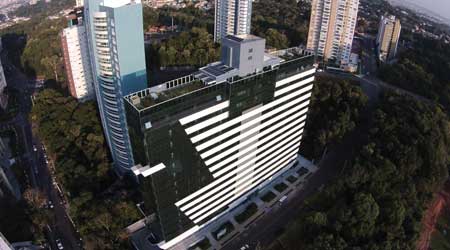 The Eurobusiness office in Curitiba, Brazil, is the world’s first LEED Zero Water building. The 14-story LEED Platinum building marries water efficiency and resilience by treating 100 percent of its wastewater onsite.USGBC
The Eurobusiness office in Curitiba, Brazil, is the world’s first LEED Zero Water building. The 14-story LEED Platinum building marries water efficiency and resilience by treating 100 percent of its wastewater onsite.USGBCHow Water Efficiency Creates Resilient Facilities
Sustainability and resilience are natural allies. Water efficiency, an increasing priority for facility managers, unquestionably helps make facilities more resilient in the face of extreme weather or natural disasters.
As building owners and facility managers plan and prioritize capital improvements, resilience during extreme weather, power interruptions, and other events has become a priority. Not only can such events pose risks to buildings, but also they can present risks to occupants and sustained business operations, and can have offsite impacts. Defined as “the ability to prepare and plan for, absorb, recover from, and more successfully adapt to adverse events,” resilience is a process as much as a state of being. For building owners and facility managers, resilience must be more than a buzzword. Rather, this conceptual goal should be used to guide strategic planning and continuous improvement. With this lens, building owners and facility managers can systematically foresee potential hazards, and take steps to prepare for response, harden their facilities, and mitigate to reduce the risks to life and property.
The link between sustainability and resilience is well established. Inherently, high-performing buildings and facilities that use fewer resources will be better positioned to withstand and bounce back from adverse events. And integrated design and performance-based operations further facilitate intentional resilience outcomes.
Water management falls within this nexus, and presents an area worthy of increased attention. Natural disasters, such as hurricanes, extreme storms, and earthquakes, can interrupt the supply of safe, potable water and the operation of sewer systems. For example, Superstorm Sandy affected 690 drinking water and wastewater utilities across 11 states and Washington, D.C. Water and wastewater system interruptions to a facility can occur from pipe breaks due to washouts, up-rooted trees, etc. And these could result in sewage spills or low water pressure. Additionally, properties can face distinct risks of flooding from storms, as well as structural failures (e.g., pipe or levee breaks associated with disasters, such as earthquakes, man-made events and accidents, or failures).
Resilient water efficiency
Building owners and facility managers have opportunities to enhance their buildings’ resilience to these risks by reducing reliance on public water systems, as well as improving management of water on site.
First, increasing water efficiency throughout a facility and its site is a core approach for both sustainability and resilience. This reduces the amount of water needed from the public water system, which in turn makes it easier to use alternative sources to maintain operations during a disaster or other interruptions to service.
Water efficiency is essentially using less water to meet facility needs. It encompasses a range of strategies including water-efficient plumbing fixtures, appliances, and HVAC units. But water efficiency also extends to approaches like landscaping – the decision to use native species that have no- or low-water needs beyond natural rainfall – and implementing irrigation best practices. EPA’s WaterSense program identifies products meeting key criteria for both water efficiency and product performance and, according to EPA, has saved trillions of gallons of water since its inception. The WaterSense program provides resources to help building owners and facility managers make the business case for water efficiency.
Beyond using less water, using alternative sources of water is another key strategy that both reduces consumption of public potable water, and enhances resilience. Alternative water systems can capture water that would otherwise go to the sewer or run off the site and instead reuse or use it appropriately onsite. Alternative water sources can include rainwater or stormwater collected at the site, sump-pump water harvesting, graywater, air-cooling condensate, reject water from water purification systems, or water reclaimed on site. In some instances, alternative sources can be leveraged to sustain life during sheltering, such as providing drinking water in an emergency.
Properly designed and implemented systems can significantly boost resilience, while reducing potable water consumption and related water and sewer bills. For example, graywater used for toilets can potentially mean that bathrooms will continue functioning even if the public water system is not available. Portland, Ore.’s innovative Hassalo on Eighth is an example of this strategy in action. The first LEED v4 for Neighborhood Development platinum project features a system that treats 100 percent of their wastewater for reuse so that the community is not dependent on the local groundwater supply.
Facility professionals should not overlook their building exteriors and sites when seeking to increase resilience. Managing rainwater is critical to reduce risks to life and property from floods. Reducing impervious areas and using green infrastructure, such as detention basins and rain gardens, can help the site mimic natural processes. Managing rainwater also creates co-benefits, such as when it may be used in lieu of potable water or as an emergency water source. In considering site and facility upgrades, understanding future storm intensity is critical. Increasingly, data is available to help assess different storm risks under changing climate scenarios.
Related Topics:














